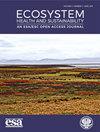中国磷供应链中磷排放的供给侧驱动因素
IF 3.4
2区 环境科学与生态学
Q1 ECOLOGY
引用次数: 4
摘要
摘要人类活动通过增加空气、土地和水的磷排放水平来干扰自然磷循环。对磷供应链和相关磷排放的供应方分析可以深入了解造成人类磷排放的潜在经济活动和转型。本研究以中国大陆为例,构建了描述1949–2012年P供应链的时间序列物理投入产出表。随后,从供应角度确定了磷供应链的关键产品和影响因素,使磷排放到环境(包括空气、土地和水)。结果表明,磷矿石是中国磷供应链中自然环境磷的重要初始供应商,2012年磷排放量占总排放量的86%。此外,粮食作物和牲畜分别是从土壤到中国磷供应链的重要初始供应商,通过种植和放牧。从1949年到2012年,初级投入水平的变化是P排放增量的最大驱动因素,其次是人口、排放强度和初级投入结构的变化。相反,生产结构的变化减少了磷的排放。这些研究结果可以为磷排放控制的供应方政策决策提供支持。本文章由计算机程序翻译,如有差异,请以英文原文为准。
Supply-side drivers of phosphorus emissions from phosphorus supply chains in China
ABSTRACT Human activities interfere with natural Phosphorus (P) cycles by introducing increased levels of P emissions to air, land, and water. A supply-side analysis of P supply chains and associated P emissions can provide insights into underlying economic activities and transitions responsible for human-induced P emissions. Taking the mainland China as the case, this study constructs time-series physical input-output tables to describe P supply chains during 1949–2012. Subsequently, it identifies critical products and influencing factors of P supply chains enabling P emissions to the environment (including air, land, and water) from the supply perspective. The results show that phosphate rock, an important initial supplier of P from natural environment to China’s P supply chain, was responsible for 86% of P emissions in 2012. Moreover, food crops and livestock are important initial suppliers of P from soil to China’s P supply chain, through cultivation and pasturing, respectively. From 1949 to 2012, the change in primary input level was the largest driver of P emission increments, followed by changes in population, emission intensity, and primary input structure. On the contrary, changes in production structure reduced P emissions. These findings could support supply-side policy decisions on P emission control.
求助全文
通过发布文献求助,成功后即可免费获取论文全文。
去求助
来源期刊

Ecosystem Health and Sustainability
Environmental Science-Management, Monitoring, Policy and Law
CiteScore
7.10
自引率
2.00%
发文量
40
审稿时长
22 weeks
期刊介绍:
Ecosystem Health and Sustainability publishes articles on advances in ecology and sustainability science, how global environmental change affects ecosystem health, how changes in human activities affect ecosystem conditions, and system-based approaches for applying ecological science in decision-making to promote sustainable development. Papers focus on applying ecological theory, principles, and concepts to support sustainable development, especially in regions undergoing rapid environmental change. Papers on multi-scale, integrative, and interdisciplinary studies, and on international collaborations between scientists from industrialized and industrializing countries are especially welcome.
Suitable topics for EHS include:
• Global, regional and local studies of international significance
• Impact of global or regional environmental change on natural ecosystems
• Interdisciplinary research involving integration of natural, social, and behavioral sciences
• Science and policy that promote the use of ecological sciences in decision making
• Novel or multidisciplinary approaches for solving complex ecological problems
• Multi-scale and long-term observations of ecosystem evolution
• Development of novel systems approaches or modeling and simulation techniques
• Rapid responses to emerging ecological issues.
 求助内容:
求助内容: 应助结果提醒方式:
应助结果提醒方式:


